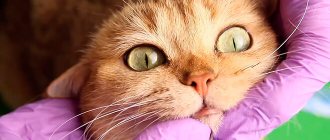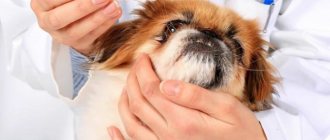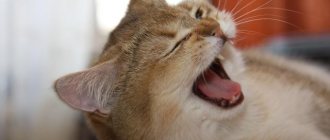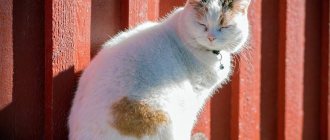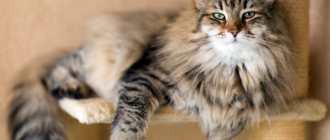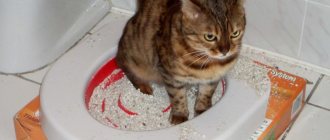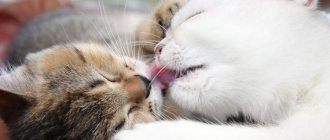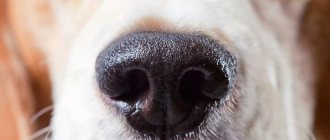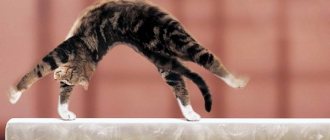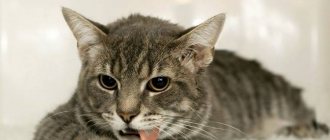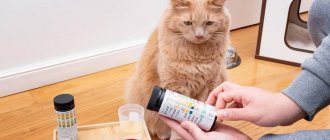Unfortunately, wounds in pets are a fairly common occurrence that many owners have to deal with. Most often, cuts, bruises or scratches heal on their own and do not pose any danger to the animal. But there are also injuries that can greatly worsen the cat’s condition. In order not to endanger the health of your pets, “Murkosha” will tell you the basic rules of treatment and first aid that all owners need to know.
1) What is a wound 2) How to determine that a cat has a wound 3) First aid and wound treatment 4) Further care 5) Possible complications 6) Prevention of wounds in cats
What is a wound
A wound is an injury that results in a violation of the integrity of the skin or mucous membrane. There are several types of wounds in kittens:
1. An incised wound is the result of injury with a sharp object (knife, razor). This type of damage heals quite quickly, since the tissue is almost not destroyed. 2. A puncture wound appears as a result of interaction with a long and sharp object (an awl, a knitting needle). Such damage is characterized by a small wound area on the surface of the body and a relatively large depth. 3. A chopped wound is the result of a strong impact from a sharp object at an angle to the tissue. It causes severe pain and bleeding. 4. A bruised wound appears from a blow to the body with a blunt object. Muscle tissue is crushed, which increases the chance of wound infection. 5. A crushed wound is the same as a bruised one, but with more severe damage and much more extensive. 6. Bite wound - damage received during interaction with other animals. It has its own danger - infection can occur with the microflora of the attacking animal's oral cavity. Therefore, complications often occur with this type of wound (rabies, tetanus, etc.).
Read more about infections in cats: What you need to know about cat infections
7. A poisoned wound is the result of contact with an animal toxic substance (snake bite, household chemicals) on the damaged skin. 8. Gunshot wound.
There are also mixed types of wounds that combine signs of several types at once. Cats can get injured in different ways: in fights with other cats or dogs, while climbing trees, roofs and fences, carelessly jumping from shelf to shelf in an apartment, and so on. Damage can also be caused by falling from a height or getting hit by a car (such wounds are most often crushed or bruised). As you can see, the vast majority of potentially dangerous situations where you can get injured are waiting for cats on the street. Let's talk a little further about how to minimize the risk.
Why are scratches from a cat dangerous?
Scratches from cats and bites from these domestic pranksters are much more infected than bites from domestic dogs. In the overwhelming majority, infectious agents located on the paws and claws of cats are not isolated. Polymicrobial flora contains streptococcal infection, staphylococcal bacilli, pasteurella and some others. It is worth noting that bacterial pathogenic microorganisms are present on the paws and claws of all cats, without exception, even the most domestic and well-groomed ones.
In addition to the bacteria described above, after a scratch a person may develop the so-called felinosis, or cat scratch fever. The marks left by a cat on the owner's body are not harmless. Cat scratch disease can cause quite serious allergic reactions in humans and provoke dangerous complications in the organs of the human body.
The spread of pathogenic bacterial pyogenic microflora is due to the fact that the claws of domestic and wild cats have a curved shape. With the help of its weapon, the cat breaks the surface layer of the dermis. As a result of the penetration of pathogenic microflora that provokes BCC, first of all, the size of the lymph nodes changes. Wounds caused by a cat take a long time to heal, as they are not even.
Cat scratches have jagged edges, which delays the regeneration and recovery process. Deep torn scratches transform into a closed type of damage. It accumulates dirt and pathogens. Before treating a wound surface formed by a cat’s claws, it is necessary to thoroughly treat it to remove all kinds of dirt and infection, which will allow the body to easily regenerate the damaged area with new tissue.
How to tell if a cat has a wound
Newly acquired wounds in pets have certain signs and characteristics that are difficult to ignore or not notice:
- swelling; - purulent discharge; - presence of bleeding; - painful sensations; - torn, peeled skin; - change in gait, limping; - increased anxiety of the animal; - bald spots, hair loss in some places; - reluctance to let the owner near any part of the body.
Read more about the signs of an unhealthy cat: Signs of an unhealthy cat
Symptoms of felinosis
From the beginning of contact with the cat, felinosis does not manifest itself in any way. A small spot forms at the site of the scratch, which later develops into a papule and a small ulcer. The wound heals very slowly and constantly festeres. Its surface remains moist despite the use of healing agents.
Swelling or swelling occurs at the site of the scratch. The following symptoms occur occasionally :
- allergic reaction;
- toxicosis;
- painful sensations in the bones and body;
- fatigue;
- insomnia.
After three weeks, a person develops a fever, which is the first sign of damage to the body. Lymph nodes in the armpits and elbows become enlarged, and upon palpation they cause discomfort and even pain. Possible suppuration, tonsillitis and a red rash.
First aid and wound treatment
If the discovered wound is not treated in time, then various pathogenic bacteria can penetrate into it. Infection of the wound leads to suppuration and subsequent complications. To prevent this from happening, you need to know the rules of first aid. Whether you can treat a wound at home depends on its severity. If these are minor scratches or abrasions, then each person is able to cope with it on their own. Regardless of where the wound is located: on the face, on the tail, on the ears or on the paws, there are uniform rules for caring for such injuries. Initial wound treatment at home is carried out as follows:
1) Wash your hands thoroughly and disinfect them with a special solution before starting to treat the injury. 2) Using scissors, carefully trim the fur around the wound. 3) Clean the wound from contamination. For this, it is best to use chlorhexidine, but iodine and brilliant green should not be used, as they can leave chemical burns on the cat’s body. Chlorhexidine is an effective antibacterial drug and has a mild aftereffect - even after drying it continues to kill bacteria. By rinsing the wound with it, bacteria and dirt are removed, which reduces tissue damage. 4) When treating a wound, use a bandage or clean cloth. You should not use cotton wool, as it may leave particles in the wound that will slow down healing. 5) Decide whether to bandage the kitten's wound. It is best to do without bandaging and leave it to heal in the fresh air. However, if your pet tries to lick or chew the wound, it should be covered (although this will slow down healing).
Volunteers at the Murkosha shelter advise all owners to treat the wound not alone, but together with someone. The fact is that kittens may experience pain and try to escape when touching the wound. Such a reaction is possible even if in ordinary life the pet behaves very quietly and calmly. If the wound is large, deep, open, or there is heavy bleeding, then the owners should contact a veterinary clinic for professional help as soon as possible. Almost all deep wounds are closed surgically. After the operation, the specialist prescribes outpatient treatment for the animal using external agents that accelerate wound healing. But before taking your pet there, the wound also needs to be treated.
Read more about how to properly interact with a veterinarian: Five rules for effective interaction with a veterinarian
Treatment with antibiotics
Antibacterial drugs are used to prevent secondary infection. As a rule, the remedy is selected by the veterinarian depending on the abrasion. The doctor will also prescribe the exact dosage. The most commonly prescribed drugs are tetracyclines, Ampicillin, Streptomycin. For infection, Amoxicillin, Clindamycin or Benzylpenicillin are recommended.
To summarize, we can say that only a veterinarian can determine how to treat a cat’s wound for effective treatment. After all, the healing process directly depends on correctly selected drugs. In any case, after providing emergency care to your pet, it must be shown to a specialist. Only a veterinarian can prescribe medications that will speed up the healing process and prevent secondary infections from occurring.
Further care
After self-treatment of the wound or a visit to the veterinarian, the healing of the kitten’s wound depends solely on proper care for it. “Murkosha” advises all owners to be patient, as this process takes up to two weeks. To speed up your pet's recovery, follow these tips:
- Do not allow the cat to lick wounds. He will instinctively want to do this, but this will not heal them. To prevent this behavior, veterinarians advise using a special collar that will prevent the cat from scratching and licking the wound. — If your pet has dressings, they must be changed regularly when they become dirty and always kept dry. If you cannot change the bandages yourself, then ask friends for help or go to the clinic for bandaging. — The cat must take all prescribed medications on time. The treatment plan will be drawn up in advance by the veterinarian, and all you have to do is strictly follow it. If this is not done, the bacteria will become resistant to the drug and the treatment will be in vain. — Not only the use of medications, but also a balanced diet can speed up your pet’s recovery. The cat should be fed more often than usual - about 5 times a day. The cat's diet must include protein, as it helps healing. In addition, food should be rich in vitamins. All these requirements are met by professional super-premium and holistic-class food. — Report any deterioration in your pet’s condition to your doctor immediately.
Drugs
Today, in the pharmacy chain you can purchase a large number of medications that disinfect the wound. Accordingly, the choice of medication directly depends on the wound surface, its size, depth and the possibility of further infection. Treatment measures, prevention of secondary infection and eradication of surface healing depend on these factors.
Hydrogen peroxide
Treatment with this drug is possible no later than 2 hours from the moment of injury. Do not pour the bottle directly onto the wound. It is better to moisten the swab with the solution and treat the surface. If possible, apply a sterile dressing. But remember that during treatment you must hold your pet tightly.
Levomekol ointment
Used to accelerate wound healing and to prevent infection. The main active component accelerates metabolic processes in tissues and promotes the removal of purulent contents. To treat and prevent further infection, apply a bandage to the surface of the wound.
Baneocin ointment
It is excellent for treating infected wounds. The drug is not addictive and can be used up to 2-3 times a day. After treatment, it is recommended to cover the wound with a sterile cloth.
Iodine solution
Important! Do not apply the product directly to the wound surface. Dissolved iodine can be used to treat the edges of the wound without touching the wound itself. But, if there is a weeping wound, iodine will dry the surface, thereby protecting the animal from further infection.
Brilliant solution
Treating the wound with brilliant green should be done very carefully to avoid burns. It is not recommended to treat a weeping or bleeding wound with brilliant green. At its core, brilliant green solution is a powerful external antiseptic. Penetrating into the wound surface, it destroys pathogenic microorganisms and prevents the proliferation of bacteria.
Therefore, it is better to apply an aseptic dressing treated in a solution of brilliant green to the wound surface.
Furacilin solution
Furacilin still occupies a leading position for wound treatment. As a rule, to prepare a solution, 20 mg tablets are prescribed, which must be dissolved in 100 ml of water. The prepared solution should be stored in the refrigerator. The wound surface is treated with the product 2-3 times a day.
Rinse should be done away from the wound if it is fresh, and towards the wound if it has an inflammatory process.
Possible complications
As we have already found out, if you do not treat your pet in a timely manner, pathogenic bacteria can penetrate into the wound and suppuration will begin to develop in it. If the wound is closed, then pus accumulates inside and an abscess appears. Such replenishment cannot be cured at home with the help of an antiseptic and bandages, so the treatment process is best entrusted to an experienced veterinarian. He will be able to assess the extent of the inflammation and choose the appropriate treatment strategy for your cat.
Complications can also arise if the wound is not completely treated. This can happen if the owners, for example, stop giving the cat medications without completing the course of treatment to the end. At first, it will seem that the pet is absolutely healthy and has finally returned to normal life. But in fact, inflammatory processes will still take place inside his body, which will slowly spread throughout the body. This will affect the general physical condition of the pet, as well as all its internal organs. The immune system will be weak, which means the cat will be highly susceptible to all kinds of viruses and diseases. Thus, if the wound is not completely treated in a timely manner, this will lead to the emergence of new, more dangerous diseases.
Why you shouldn't ignore cat scratches
The causative agent of lymphoreticulosis, or non-bacterial lymphadenitis, lives in the body of many cats. At the same time, the animal itself is not sick and looks cheerful and healthy. The infection is transmitted to humans through scratches and bites. If, despite all the measures you have taken, the scratches begin to become inflamed, reddened or rotted, consult an infectious disease specialist.
Based on the results of the examination, you will be prescribed treatment. Most often, the doctor prescribes antibiotics for internal and external use. The course of treatment depends on the severity of the disease and ranges from 7 to 14 days.
Do you want to avoid such consequences from communicating with your beloved Murka? Get your cat vaccinated on time. It is worth noting that even a vaccinated animal can become infected again if it goes outside unhindered. Therefore, you should not let your guard down. After all, even their beloved owner can be scratched.
Prevention of wounds in cats
Statistics show that in 8/10 cases cats are injured if they walk outside unattended. Therefore, the best and most effective way to prevent wounds in cats is to keep them exclusively at home or let them out only in a protected limited space (for example, in the local area of a private house) on a harness under the supervision of their owners. There are too many dangers on the street that threaten a cat: dogs, cars, knackers, and, in the end, other cats. If a pet purr goes out for a walk, then there is a very high probability that sooner or later she will encounter one of these dangers. In this case, there is a risk that the cat will die immediately or receive such a wound that it will run away, get lost and not be able to return home.
Read more about the dangers of self-walking: Self-walking - when freedom means death
At home, the main danger comes from the windows - if they are not protected by special “anti-cat” nets. When ventilated, the cat can easily fall out of the window. Don't rely on mosquito nets - if desired, the cat will tear them apart in no time. If the cat stays exclusively at home, and the windows are protected, then the risk for her to get injured will be minimal (and even in this case, we are more likely to talk about minor scratches or abrasions). And yet, just in case (especially if you have more than one pet), regularly check if your cat has any injuries, abrasions or wounds. It is most convenient to do this while you are stroking it, since it is not always possible to notice changes during a visual inspection.
“Murkosha” hopes that now all owners know how to help their pet in case of danger. It is very easy to provide first aid when a kitten is injured, so do not put it off until later and try to treat the wound as quickly as possible. Well, it’s best to avoid this altogether: eliminate self-walking and protect the windows with special nets.
Causes
Among the gaping wounds are the following:
- Chipped.
- Cut.
- Bitten.
- Torn.
- Firearms.
- The result of the action of toxic substances is a mixture.
Stab and cut injuries are characterized by smooth edges and severe bleeding. Lacerations and bitten wounds are characterized by a large area of damage and minor hemorrhage. Cats get them during a fight. Injuries from pneumatic weapons inflicted by animal torturers cannot be ruled out. Caustic substances cause skin burns. The defects become infected and mixed forms are formed.
With closed injuries, swelling and discoloration of the injured area are observed, and internal bleeding cannot be ruled out.
The wound has festered
Diagnostics
Large wounds are fairly easy to diagnose on your own. They heal well with regular antiseptic treatment, the amount of purulent contents decreases, and the animal behaves calmly.
Only a veterinarian can diagnose a fistula or abscess. You should show the cat to a specialist as soon as possible, since a fistula can lead to the development of dangerous complications. For an accurate diagnosis, X-rays or MRIs with contrast are done.
Popular Are cat tongue ulcers dangerous?

